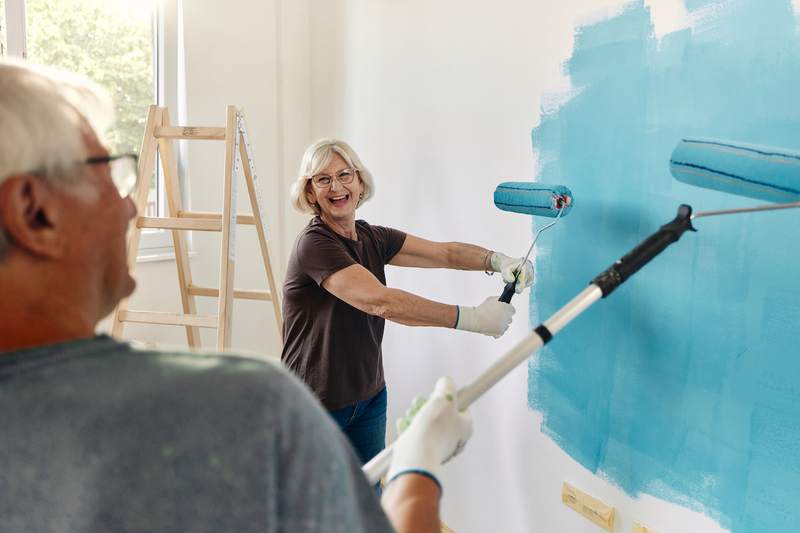Owning a home is both an ongoing responsibility and an ongoing expense. From yardwork to leaky sinks and kitchen remodeling to replacing the roof, there’s always something that needs fixing or upgrading. And the price tag can vary as much as the tasks themselves — from a few bucks all the way up to tens of thousands of dollars.
When the project requires borrowing money to pay for it, two of the most common choices for homeowners are a personal loan or a cash-out refinance.
Both options have pros and cons, so it’s important to understand how they stack up against each other and ensure you’re making the best choice for your finances:
- Funding Improvements With a Personal Loan
- Funding Improvements With a Cash-Out Refinance
- Pros and Cons of a Personal Loan vs. Cash-Out Refinance
- How To Choose Between a Personal Loan and Refinance
- The Bottom Line on Paying For Home Improvements
Funding Improvements With a Personal Loan
A personal loan is an unsecured loan that must be paid back with interest over a certain time frame.
Compared with mortgages, personal loans require less documentation to prove your creditworthiness. Typically, lenders will need your identification, credit score and history, debts, and proof of income. What you don’t need, however, is equity in your home.
Lenders generally respond to an application within a few days. If approved, the lender will tell you how much you can borrow based on your financial situation, with the typical range from $5,000 to $45,000.
The loan usually will have a fixed interest rate and a repayment term of two to five years. The interest rate will be influenced by your credit score and market forces. Since it’s an unsecured loan, don’t be shocked if you see a higher interest rate than you would for a mortgage.
For example, if a homeowner takes out a personal loan for $10,000 at a 9% interest rate with a five-year repayment schedule, the monthly payment would be $208, and they would pay $2,455 in interest over the life of the loan.
Can you take out a personal loan for home improvements? The answer is yes.
“Personal loans can be easier to get since they don’t require a certain amount of equity in a property, but they need to be paid back on time and in full to avoid bankruptcy because they lack collateral,” says Martin Orefice, a real estate broker and CEO of Rent To Own Labs, based in Orlando, Florida.
Though many lenders offer designated home improvement loans, these are essentially personal loans marketed to homeowners.
Funding Improvements With a Cash-Out Refinance
Taking a cash-out refinance for home improvements is a more complicated process. It requires you to apply for a new, larger mortgage based on your home’s current value, and you use that loan to repay your current mortgage. The leftover cash can be used for anything you like.
The advantage of refinancing your mortgage in this way is you can borrow more money, depending on how much equity you have, and repay it over a longer time at a lower interest rate.
Applying for a cash-out refinance is getting a new mortgage, so you’ll need to provide your lender with full documentation of your income, assets, and debts. You also will need sufficient equity in your home, usually at least 20%; a debt-to-income ratio of less than 50%; a credit score of at least 580; and proof of employment and income.
You also need to pay refinance closing costs on your new mortgage, which run about $5,000 on average.
Refinancing for home improvements resets the term of your mortgage, and could extend how many years you need to make payments. If your original mortgage had a 30-year term and you’ve been paying it and building equity for years, then refinancing to a new 30-year loan will start you over.
Pros and Cons of a Personal Loan vs. Cash-Out Refinance
Should you get a personal loan or a cash-out refinance for home improvements? To help you better understand which type of loan works best for your situation, we’ve outlined their differences, as well as their pros and cons.
Pros and cons of using a personal loan for home improvements
Here are some advantages to taking out a personal loan to pay for home improvements:
- No collateral. If you’re unable to repay your personal loan, your credit score will take a hit and you’ll likely get slammed with late payment fees and a lawsuit. But you won’t risk losing your home, car, or other major assets.
- Easy application process. Most of today’s lenders offer same-day approval and quick loan disbursement. By filling out an online application, you can quickly find out how much you could borrow and what your interest rate will be, among other important details.
- Fixed repayment plan. Personal loans typically come with a fixed interest rate and a specific repayment term. That means that you can determine exactly how much you’ll have to pay each month, and for how long.
And here are some disadvantages:
- Higher interest rates. Personal loans are unsecured, and typically have higher interest rates than a home equity line of credit or home equity loan.
- Requires good credit. To be approved for a personal loan, you should have a decent credit score. The higher your score, the better the rate you’ll receive, though the opposite can be true if you have a score that’s on the lower end.
- The interest isn’t tax deductible. While the interest payments you make on loans are often tax deductible, interest on most personal loans is not. The only ways you can deduct an unsecured loan’s interest payments are if you use it for business expenses, qualified higher education expenses, and taxable investments.
Pros and cons of using a cash-out refinance for home improvements
Here are some reasons why homeowners might want to do a home improvement refinance and get cash out to pay for the project:
- Large loan amounts. Since homes are major investments, mortgages can be in the range of hundreds of thousands or millions of dollars. If you’re planning on completely renovating your home, a cash-out refinance will allow you to take out larger sums of money than you can typically get with a personal loan.
- The interest is deductible. You can receive a tax benefit if you use the funds for substantial improvements to your home. This could help offset the refinancing loan’s overall cost.
- Improvements could add equity. As you upgrade your home, it increases in value. Refinancing to make improvements now means your home will be more attractive to potential buyers as a result.
And here are some drawbacks:
- Your home is collateral. Since a cash-out refinance loan is a secured loan, your home is used as collateral in the event that you can’t repay the balance. This means you could lose your home if you fail to make your payments.
- Strict requirements. Though personal loans can be relatively easy to get, a cash-out refinance loan requires a lot from potential borrowers. Generally, you need a minimum credit score of 600 to 640, your debt-to-income ratio can’t exceed 50%, and you must have at least 20% equity in your home.
- Longer repayment period. Though this can be seen as a benefit, it could also become an issue for some borrowers. That’s because restarting your mortgage’s repayment period means you’ll be making interest payments longer, effectively increasing your expenses over time.
How To Choose Between a Personal Loan and Refinance
So, is it better to refinance or get a personal loan to make home improvements? When it comes to choosing between a personal loan or refinance, you need to consider your financial situation and the scope of your home improvement project.
If you have decent credit and only need a few thousand dollars, a personal loan could be the right fit.
However, if you’ve been in your house for a long time and built up enough equity, you could take out a much larger amount of money and do more expensive work around the house by going with a cash-out refinance.
The Bottom Line on Paying For Home Improvements
Every home needs improvements or repairs eventually. Fortunately, there are several options for borrowing the cash to pay for them. How much you need and the cost of repaying the loan are essential factors in deciding if a personal loan or a refinance mortgage is the right way to go. Understanding how each works and the pros and cons of both options equips you to make a decision that’s right for you.






